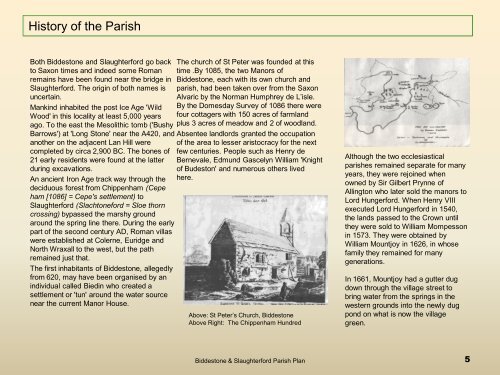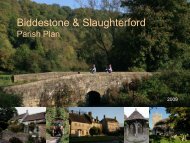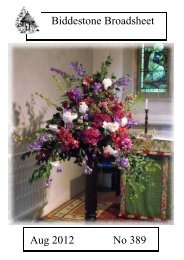Grant Proposal for Project Name - Biddestone Village
Grant Proposal for Project Name - Biddestone Village
Grant Proposal for Project Name - Biddestone Village
Create successful ePaper yourself
Turn your PDF publications into a flip-book with our unique Google optimized e-Paper software.
History of the Parish<br />
Both <strong>Biddestone</strong> and Slaughter<strong>for</strong>d go back The church of St Peter was founded at this<br />
to Saxon times and indeed some Roman time .By 1085, the two Manors of<br />
remains have been found near the bridge in <strong>Biddestone</strong>, each with its own church and<br />
Slaughter<strong>for</strong>d. The origin of both names is parish, had been taken over from the Saxon<br />
uncertain.<br />
Alvaric by the Norman Humphrey de L‟isle.<br />
Mankind inhabited the post Ice Age 'Wild By the Domesday Survey of 1086 there were<br />
Wood' in this locality at least 5,000 years four cottagers with 150 acres of farmland<br />
ago. To the east the Mesolithic tomb ('Bushy plus 3 acres of meadow and 2 of woodland.<br />
Barrows') at 'Long Stone' near the A420, and Absentee landlords granted the occupation<br />
another on the adjacent Lan Hill were of the area to lesser aristocracy <strong>for</strong> the next<br />
completed by circa 2,900 BC. The bones of few centuries. People such as Henry de<br />
21 early residents were found at the latter Bernevale, Edmund Gascelyn William 'Knight<br />
during excavations.<br />
of Budeston' and numerous others lived<br />
An ancient Iron Age track way through the here.<br />
deciduous <strong>for</strong>est from Chippenham (Cepe<br />
ham [1086] = Cepe's settlement) to<br />
Slaughter<strong>for</strong>d (Slachtone<strong>for</strong>d = Sloe thorn<br />
crossing) bypassed the marshy ground<br />
around the spring line there. During the early<br />
part of the second century AD, Roman villas<br />
were established at Colerne, Euridge and<br />
North Wraxall to the west, but the path<br />
remained just that.<br />
The first inhabitants of <strong>Biddestone</strong>, allegedly<br />
from 620, may have been organised by an<br />
individual called Biedin who created a<br />
settlement or 'tun' around the water source<br />
near the current Manor House.<br />
Above: St Peter‟s Church, <strong>Biddestone</strong><br />
Above Right: The Chippenham Hundred<br />
<strong>Biddestone</strong> & Slaughter<strong>for</strong>d Parish Plan<br />
Although the two ecclesiastical<br />
parishes remained separate <strong>for</strong> many<br />
years, they were rejoined when<br />
owned by Sir Gilbert Prynne of<br />
Allington who later sold the manors to<br />
Lord Hunger<strong>for</strong>d. When Henry VIII<br />
executed Lord Hunger<strong>for</strong>d in 1540,<br />
the lands passed to the Crown until<br />
they were sold to William Mompesson<br />
in 1573. They were obtained by<br />
William Mountjoy in 1626, in whose<br />
family they remained <strong>for</strong> many<br />
generations.<br />
In 1661, Mountjoy had a gutter dug<br />
down through the village street to<br />
bring water from the springs in the<br />
western grounds into the newly dug<br />
pond on what is now the village<br />
green.<br />
5






